– Banridamon K Sohkhia
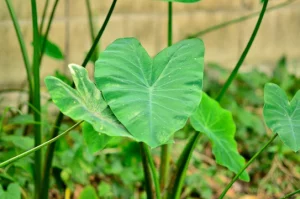 Meghalaya is a home to a diverse range of wild vegetables many of which are edible and consumed by local population some of which are colocasia plants, wild spinach, wild mushroom, bamboo shoots, ferns, wild beans, bitter gourd, wild eggplant, and wild tomatoes each known by their many local names in the different regions of the state.
Meghalaya is a home to a diverse range of wild vegetables many of which are edible and consumed by local population some of which are colocasia plants, wild spinach, wild mushroom, bamboo shoots, ferns, wild beans, bitter gourd, wild eggplant, and wild tomatoes each known by their many local names in the different regions of the state.
These plants grow in different seasons. In the remote areas of Meghalaya these wild vegetables aid in meeting the nutritional requirements among the economically backward, who can’t afford to buy commercial vegetables in the markets.
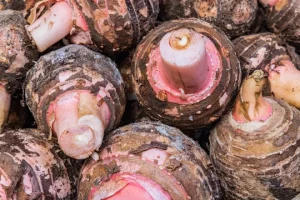 Colocasia or colocasia esculenta is an important member of the family Arecaceae. Colocasia is a large herb that grows upto 1-2 metres. The leaves are large and smooth which may be shaped in the form of a heart or arrow, and drooping downwards. It is an important naturally grown vegetable in Meghalaya, it is also grown as a crop by the farmers of the state. Commonly known as the ‘kashriew’ among the Khasi tribe of Meghalaya, all parts of the colocasia plant are edible – the leaves, the petioles, the corms (underground stem).
Colocasia or colocasia esculenta is an important member of the family Arecaceae. Colocasia is a large herb that grows upto 1-2 metres. The leaves are large and smooth which may be shaped in the form of a heart or arrow, and drooping downwards. It is an important naturally grown vegetable in Meghalaya, it is also grown as a crop by the farmers of the state. Commonly known as the ‘kashriew’ among the Khasi tribe of Meghalaya, all parts of the colocasia plant are edible – the leaves, the petioles, the corms (underground stem).
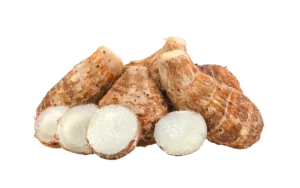 According to the “Colocasia Package of Practice for Cultivation in Meghalaya ” pamphlets published and distributed by the ICAR Research Complex for NEH region, Colocasia is a rich source of carbohydrates, minerals and vitamins. Starch is the main constituent of carbohydrates in this plant.
According to the “Colocasia Package of Practice for Cultivation in Meghalaya ” pamphlets published and distributed by the ICAR Research Complex for NEH region, Colocasia is a rich source of carbohydrates, minerals and vitamins. Starch is the main constituent of carbohydrates in this plant.
In Meghalaya, the farmers usually grow the local varieties available. However, the ICAR complex for NEH region Umiam has identified several genotypes or varieties like ML-1, ML-2, ML-9, BCC-1 and Nadial Local which are not only high yielding but also moderately resistant to certain diseases that may affect this particular plant like the leaf blight which is very common in the state.
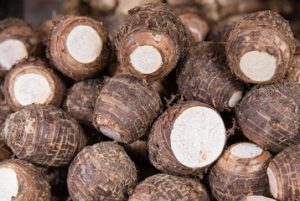 In addition to that, the ICAR has recommended a few varieties of colocasia which can be grown in Meghalaya, ML- 1 with only 13 percent probability of getting infections, Ml-2 with 18 percent chance of getting infections, ML- 9 with 19 percent and BCC only 10 percent.
In addition to that, the ICAR has recommended a few varieties of colocasia which can be grown in Meghalaya, ML- 1 with only 13 percent probability of getting infections, Ml-2 with 18 percent chance of getting infections, ML- 9 with 19 percent and BCC only 10 percent.
The colocasia gets ready for harvest when most of the leaves turn yellow and generally it takes 6-8 months after planting depending upon the variety. These plants also known as taro or elephant ear plants have significant economic value in various ways:
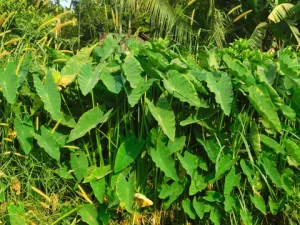 1. Food source: Colocasia corms or the underground stems and leaves are edible and rich in nutrients, making them a valuable food source.
1. Food source: Colocasia corms or the underground stems and leaves are edible and rich in nutrients, making them a valuable food source.
2. Medicinal uses: In Meghalaya, the plant has traditional medicinal applications, such as treating inflammation, fever, and skin conditions.
3. Ornamental value: Colocasia’s large, decorative leaves make it a popular ornamental plant in gardens and landscapes.
4. Cultural importance: Locally, colocasia contributes to the traditional cuisine and culture – people from different areas has got different styles of cooking it while some may simply boil it with dry fish and chillies and other various ingredients some may fry and some used it to pack the meat or any other foods and steam it to allow the good aroma to enter the meat and it is considered a delicacy by the locals.
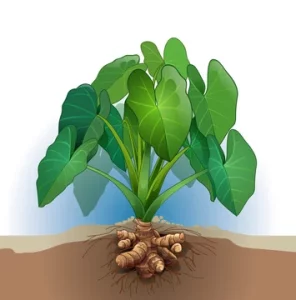 5. Economic potential: Colocasia is also cultivated for commercial purposes, providing income opportunities for farmers and rural communities.
5. Economic potential: Colocasia is also cultivated for commercial purposes, providing income opportunities for farmers and rural communities.
6. Cosmetic uses: Though it is not practise in Meghalaya but the plant’s extracts are used in skincare products, valued for their antioxidant and anti-inflammatory properties by others culture.
7. Animal feed: Colocasia leaves and corms are used as animal feed, particularly for pigs in the remote areas of Meghalaya.
8.Health benefits: Colocasia leaves are packed with essential nutrients, making them a valuable addition to a balanced diet. Several sources also claim that the leaves of colocasia  plants (100gms) contain approximately 43 calories with 7 gms carbohydrates, 3 gms protein, 3 gms dietary fibre. These leaves are known to be rich in vitamins A, C, and B-complex vitamins like folate and riboflavin. They are also known to be abundant in minerals such as calcium, potassium, iron, and magnesium. These leaves also contain antioxidants like beta-carotene and flavonoids.
plants (100gms) contain approximately 43 calories with 7 gms carbohydrates, 3 gms protein, 3 gms dietary fibre. These leaves are known to be rich in vitamins A, C, and B-complex vitamins like folate and riboflavin. They are also known to be abundant in minerals such as calcium, potassium, iron, and magnesium. These leaves also contain antioxidants like beta-carotene and flavonoids.
For those suffering from high blood pressure related issues, taro leaves can prove to be very beneficial. Since traces of Omega 3 fatty acids are also found in these leaves, they help in normalising high blood pressure levels. Therefore, patients suffering from high blood pressure are advised to include taro leaves as a part of their diet.
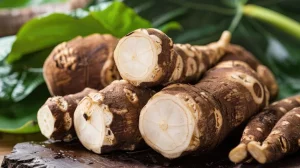 Taro leaves possess many nutritional properties: The amount of fat in these is less. These leaves are rich in fibre and methionine, which help in reducing increased cholesterol levels as well.
Taro leaves possess many nutritional properties: The amount of fat in these is less. These leaves are rich in fibre and methionine, which help in reducing increased cholesterol levels as well.
Beneficial for eyes: Vitamin A is often found in sufficient amounts in taro leaves. It is very helpful in keeping the eyes healthy. If you include these leaves in limited quantities in your diet, you can avoid eye related diseases like myopia and cataract.
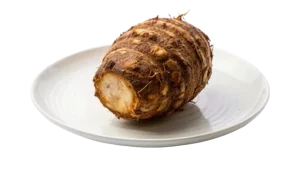 Helpful in reducing weight: Taro leaves also help in reducing weight. They contain a high amount of protein and low amount of fat. You can also include taro leaves in your weight loss diet. Apart from this, these leaves are also rich in calcium and potassium, which protects you from many serious diseases.
Helpful in reducing weight: Taro leaves also help in reducing weight. They contain a high amount of protein and low amount of fat. You can also include taro leaves in your weight loss diet. Apart from this, these leaves are also rich in calcium and potassium, which protects you from many serious diseases.
Helpful in reducing weight: Taro leaves also help in reducing weight. They also contain a high amount of protein and low amount of fat. One can also include taro leaves in one’s weight loss diet. Apart from this, these leaves are also rich in calcium and potassium, which protects you from many serious diseases.
Helpful in formation of red blood cells: Taro leaves are no less than a boon for anaemic patients. They are rich in iron, which helps in the formation of red blood cells
Nutrition: Taro root is an excellent source of dietary fibre and good carbohydrates, which both improve the function of the digestive system and can contribute to healthy weight loss. Its high levels of vitamin C, vitamin B6, and vitamin E also help to maintain a healthy immune system and may eliminate free radicals.
Apart from all the nutritional benefits, the plant helps maintain soil health, prevents erosion, and supports biodiversity. In Meghalaya, colocasia is an important crop, particularly in rural areas, where it is cultivated for food, medicine, and cultural purposes. The economic value of colocasia plants contributes significantly to the livelihoods of rural communities in the region.
(The author is a student at College of Agriculture, Kyrdemkulai, Ri Bhoi)



